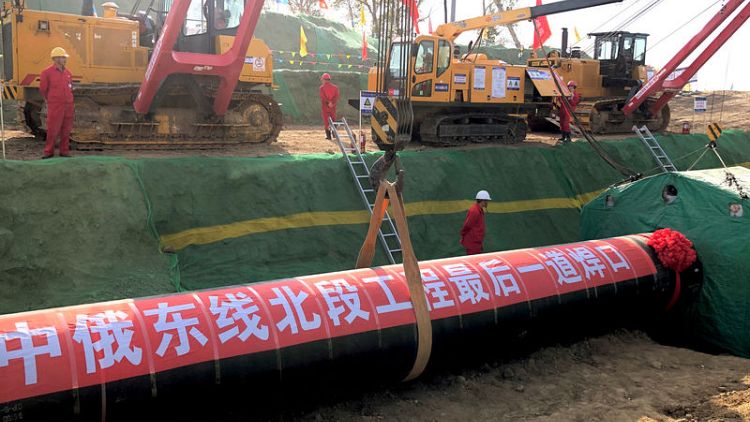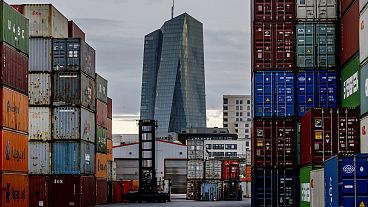By Muyu Xu, Chen Aizhu and Olesya Astakhova
HARBIN, China/SINGAPORE/MOSCOW (Reuters) - Across China's coal-burning northeastern provinces, pipelines are being laid, contracts signed and coal-fired boilers ripped out ahead of the arrival next week of the country's first piped natural gas from Russia.
The 'Power of Siberia' pipeline, due to open on Dec. 2, will pipe natural gas around 3,000 km (1,865 miles) from Russia's Siberian fields to the fading industrial region, which has lagged the push to gas in China's south and east.
The pipeline - which will deliver gas under a 30-year, $400 billion (£312 billion) deal signed in 2014 - has the potential to transform northeast China's energy landscape and even slow the country's surging imports of liquefied natural gas (LNG).
It will also make Russia a key supplier to China, to rival Turkmenistan and Australia, boosting ties amid Beijing's trade war with the United States.
More immediately, it poses a challenge for the sole marketer of the gas, China National Petroleum Corp (CNPC), or PetroChina, as it looks to drum up demand in the relatively sparsely populated region that has relied on coal for heating during sub-zero winters.
The pipeline will emerge in Heilongjiang, which borders Russia, and feed on to Jilin and Liaoning, China's top grain hub, where rust belt industries have long been overshadowed elsewhere.
The region's industry and 68 million city dwellers consume just 14 billion cubic meters (bcm) of gas a year, well below the 38 bcm the pipeline will deliver at full capacity by 2025.
Russia's Gazprom <GAZP.MM> has said it expects to supply 4.6 bcm in 2020, rising to 10 bcm in 2021, 16 bcm in 2022, 21 bcm in 2023 and 25 bcm in 2024.
(GRAPHIC: Map of the Power of Siberia gas pipeline through China - https://fingfx.thomsonreuters.com/gfx/ce/7/7522/7504/PowerSiberiaMapthroughChina.png)
With local power prices capped by authorities to support manufacturing, and cheaper imported coal available via Liaoning's Dalian port, CNPC faces a tough task to sell gas.
"It will take a long time to nurture a market in the northeast where gas-fired power generation barely exists and the industrial sector is weak," said Li Yao, chief executive of consultancy SIA Energy.
"With no take-or-pay contracts in place (domestically), CNPC shoulders most of the marketing risk."
PRICE TAKER, LOSS MAKER
Neither PetroChina nor Gazprom has revealed the gas pricing terms, but Beijing-based analysts said the price is linked to crude oil or a basket of competing fuels.
Ling Xiao, a PetroChina vice president in charge of gas marketing, said last month Siberian supplies would be priced "slightly lower" than piped imports from Turkmenistan, but the company "will still be making a loss as (the price) exceeds that of domestic city-gate benchmark rates."
Several Russian gas industry sources said the pricing could be revised down as volumes increase due to a fall in global oil prices from around $100 a barrel when the deal was signed to around $60 now.
However, the pricing formula remains known by only a few due to its commercial sensitivity, according to one source. Gazprom said it will not comment on pricing.
PetroChina declined to comment on the pipeline or its plans to boost gas take-up.
However the company, which supplies 70% of China's gas, has been working for the past five years to put distribution infrastructure in place.
A 3,371 km (2,095 mile) trunkline linking the arrival point in Heihe to Shanghai is being laid in phases and slated for completion by 2024, state media reported.
PetroChina completed a 728 km (452 mile) section to Changling in Jilin province in July, and slashed construction time on a short leg that will ensure gas to parts of north China this winter. A 1,100 km extension to Yongqing in Hebei province is due by end-2020.
PetroChina has also made its first foray into regional midstream delivery - between national pipelines and city networks - building part of a planned Heilongjiang grid connecting a dozen key cities, Caixin reported in November.
And the firm plans 5-6 bcm of underground storage, to be built in depleted gas wells in Daqing, Liaohe and Jilin to cope with the off-season demand trough, said Ding Guosheng, a gas storage expert with the company.
CLOSER TIES
The pipeline will cement China's spot as Russia's top export market and give Russia a potentially enormous new market outside Europe.
Russian President Vladimir Putin has said trade between the neighbours would reach a record $100 billion this year, up from $87 billion in 2018. Moscow sees that figure rising to $200 billion by 2024 thanks in part to gas.
"Russia is leveraging well on (China's) trade war ... In the aftermath of western sanctions, Russia has turned to China and won investment, markets and technology," said Professor Feng Yujun, director of Russia and Central Asia Research at Fudan University.
As Beijing battles air pollution, analysts at IHS market say China's gas demand is poised to surge by half between 2018 and 2025, at which point Siberian gas is slated to supply a tenth of China's total gas demand.
(GRAPHIC: Russia trade balance with China hits 13-year high as crude shipments scale new record - https://fingfx.thomsonreuters.com/gfx/ce/7/7527/7509/RussiaChinaCrudeFlowsandTradeBalance.png)
If the northeast region is unable to absorb the full 38 bcm gas by 2025, some fuel will be diverted to north China, where it could likely compete on cost against imported LNG, said Jenny Yang of IHS Markit.
RETAIL JOSTLING
Meanwhile, city gas distributors in Heilongjiang such as China Gas Holdings <0384.HK> and Hongkong and China Gas Co. Ltd <0003.HK> that provide "last-mile" connections to users are eyeing a potential boon.
"China Gas has over the past 10 years spent more than 10 billion yuan ($1.4 billion) winning distribution licenses and laying pipelines in northeast region," Frank Li, assistant to president of China Gas Holdings, told Reuters. "Now it's time to reap the fruits."
In Heilongjiang's capital Harbin, the firm, together with PetroChina's Kunlun Energy, is converting hundreds of heating stations - centres that pipe hot water to nearby residents - from coal to gas.
Recent heavy snow pushed temperatures below freezing, but workers are still racing to get ready for Russian gas.
"The pipelines are all settled and we are just waiting to connect them into our boilers," said a worker at a Harbin heating station.
(Reporting by Muyu Xu in Harbin, China and Chen Aizhu in Singapore; additional reporting by Jessica Jaganathan in Singapore and Vladimir Soldatkin & Maria Grabar in Moscow; editing by Richard Pullin)















